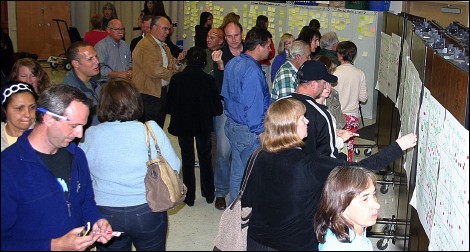Comments in italics are by Coastsider
Jim Larimer’s recent column in the Half Moon Bay Review is nearly incomprehensible if you don’t speak the secret language of property rights extremists. In it, he tries to convince us that the city of Half Moon Bay should let Chop Keenan develop Beachwood, rather than pay they settlement they (cynically, yet foolishly) agreed to. He fails to make his case.
He also uses innuendo and falsehoods to try and draw a line between what he calls "no-growthers" (anyone who doesn’t agree with his plans for the Coastside) and environmentally-minded Coastsiders (who are more than half the population).
Let’s take a look at his argument. You can mouse over the highlighted phrases for more detail if you like. I apologize in advance for the length of this deconstruction, but Mr. Larimer’s essay is full of rich material. The indented material includes his entire piece, so nothing was taken out of context.
The U.S. District Court for Northern California ruled in 2007 that the city had taken the Beachwood property by first flooding it and then by declaring it a wetland [The federal judge did not say the wetland determination was a taking]. The value taken from the property owner was established by the court to be the value added to the property if had it been fully developed as originally planned [The valuation was nuts, but it’s no longer at issue].
On March 27, 2008, the city entered into an agreement with the property owner to provide him with a permit to develop the property by June 30 of this year or to buy it at a loss-of-value price of $18 million. If they are unable to pay in full by Aug. 29, the city will owe the property owner $19.9 million plus interest on any remaining unpaid debt until it is paid in full. A bond to raise the cash to pay this debt in full by Aug. 29 will require substantial principal and interest payments to be paid from property taxes for many years to come and will limit the services that would otherwise be funded by our property taxes.
The city could act to restore the full value of the property by allowing the improperly installed storm sewer to be fixed and by additionally providing the owner with a building permit. The city would be required to confess its error in ruling that the property is a wetland [There is no evidence that this was ever an option]. No action to admit this error or to re-examine the process that made it has been taken by the city. The most likely outcome now is that the city will purchase this land in accordance with the 2008 agreement.
Mr. Larimer repeats a familiar demand: "Rewrite/reinterpret/ignore the city’s definition of wetland and let the building begin! We need the tax revenue!". There is no evidence that this is an option at Beachwood, and no evidence that it would satisfy the settlement.
We’ll discuss his tax-roll foolishness in a moment.
The act of purchasing the property acknowledges that it is a wetland unsuitable for almost any development [The property was always a wetland. That’s why they drained it]. It will be a vacant lot, an eyesore [In Mr. Larimer’s eyes, from the highway, at 45mph.] in perpetuity, sandwiched between two housing developments on similar properties. The only winner if this happens will be the no-growth political faction [No such faction exists.] whose political leadership on previous city councils created this disaster by ignoring the reason the property became flooded and then denying a permit to develop it [That’s not an option]. Beachwood is an example of their many victories in controlling growth in our community.
In other words, it’s the city’s fault for not ignoring the law at the request of a powerful developer. Not even Judge Walker went that far.
Is Beachwood an "eyesore"? I’ve walked the ground at Beachwood, and once you go in about 100 feet, beyond the highway noise, it’s really pretty nice. The open space blends into the hillside—where Mr. Larimer wants to build even more houses and a bypass—in a seamless environment. He’s right that it’s kind of homely from the highway, but it’s a bad idea to plan our communities to be most pleasing when viewed from a moving car.
Is a uniform wall of single-family homes (and their six-foot fences) along Highway 1 is more beautiful than a glimpse our hillsides and natural scrub?
Mr. Larimer keeps referring to some shadowy "no growth faction", imputing multiple strawman motives to them. Who are they? What is his evidence that they exist? He offers us nothing, only their supposed motives and mysterious misdeeds.




